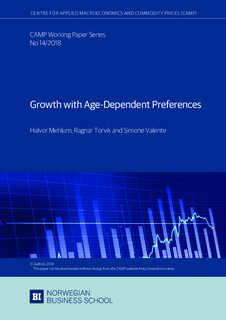| dc.contributor.author | Mehlum, Halvor | |
| dc.contributor.author | Torvik, Ragnar | |
| dc.contributor.author | Valente, Simone | |
| dc.date.accessioned | 2018-12-11T08:41:32Z | |
| dc.date.available | 2018-12-11T08:41:32Z | |
| dc.date.issued | 2018-12-10 | |
| dc.identifier.issn | 1892-2198 | |
| dc.identifier.uri | http://hdl.handle.net/11250/2577032 | |
| dc.description.abstract | We study the consequences of age-dependent preferences for economic growth and structural change in a two-sector model with overlapping generations and nondimishing returns to capital. Savings and accumulation rates depend on the relative price of services consumed by old agents and on the intergenerational distribution of income. The feedback effects originating in preferences and income distribution yield three possible long-run growth outcomes: sustained endogenous growth, decumulation traps, and bounded accumulation. In the endogenous growth scenario, the transition features rising savings and accumulation rates accompanied by distributional shifts in favor of young workers, growing employment and rising prices in the service sector. Traps are triggered by initially low capital in manufacturing and low employment in services. Bounded accumulation yielding zero long-run growth in per capita incomes is induced by preferences, not by diminishing returns to capital. | nb_NO |
| dc.language.iso | eng | nb_NO |
| dc.publisher | BI Norwegian Business School | nb_NO |
| dc.relation.ispartofseries | CAMP Working Paper Series Paper No. 14/2018; | |
| dc.subject | endogenous growth | nb_NO |
| dc.subject | structural change | nb_NO |
| dc.subject | overlapping generations | nb_NO |
| dc.title | Growth with Age-Dependent Preferences | nb_NO |
| dc.type | Working paper | nb_NO |
| dc.source.pagenumber | 18 | nb_NO |
